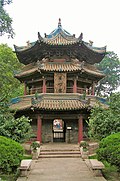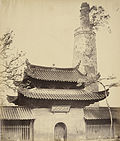Islam in China
Islam in China has a rich and longstanding history in the country. Islam has been practiced in China since the 7th century CE.[1] There are an estimated 17–25 million Muslims in China, less than 2 percent of the total population.[2] Though Hui Muslims are the most numerous group,[3][4] the greatest concentration of Muslims reside in northwestern China’s Xinjiang autonomous region, which contains a significant Uyghur population. Lesser yet significant populations reside in the regions of Ningxia, Gansu and Qinghai.[5] Of China's 55 officially recognized minority peoples, ten of these groups are predominantly Sunni Muslim.[5]
Manchu officials in the Qing executed a Muslim family in 1784 in Xinjiang because their relatives revolted in Gansu despite the fact they had no idea their relatives were revolting.[6]
Hundreds of thousands of Turkic Muslims have been detained in Xinjiang.
There is a policy of stripping Muslim buildings of Arabic features all over China, and in some cases replacing them with traditional Chinese designs. During Deng Xiaoping’s liberal era, a new mosque-building boom began, with a fashion for domed prayer halls and tall, slender minarets. Xi Jinping became General Secretary of the Chinese Communist Party as well as the top leader of China in 2012. In 2017, the Islamic Association of China said “Mosque architecture needs to be in harmony with our national characteristics.” In 2019 the “Five-Year Plan on the Sinicisation of Islam”, set out to standardise Chinese style in everything from Islamic clothing to ceremonies and architecture. It called for the “establishment of an Islamic theology with Chinese characteristics”. At least 1,714 mosques had Arabic-style features removed between 2018 and 2023.
The government also removed crosses from the roofs of over a thousand Christian churches and demolished a vast church — the Golden Lampstand Church in Shanxi province — in 2018. The government is also trying to stop under-18s from entering religious sites, or even practising religion at all.[7]
Islam In China Media
Chinese-style minaret of the Great Mosque of Xi'an, one of China's oldest mosques.
Guang Ta minaret, Huaisheng Mosque. The minaret was built in the 10th century.[source?] Photograph from 1860.
The tombs of Sa-Ke-Zu and Wu-Ko-Shun at Mount Lingshan, Quanzhou
Jinan Great Southern Mosque was completed during the reign of Temür Khan, Emperor Chengzong of Yuan
Weizhou Grand Mosque, constructed during the Ming dynasty
Hu Dahai was a Chinese Muslim general of the Hongwu Emperor
Chinese Muslim explorer and admiral, Zheng He
The seventh voyage of Zheng He
References
- ↑ Pillsbury, B. L. K. (1981), "Muslim History in China: A 1300-year Chronology", Journal of Muslim Minority Affairs, 3 (2): 10–29, doi:10.1080/02666958108715833.
- ↑ Poston, Dudley L.. The Muslim Minority Nationalities of China. pp. 4. https://paa2010.populationassociation.org/papers/100485.
- ↑ Beech, Hannah. "If China Is Anti-Islam, Why Are These Chinese Muslims Enjoying a Faith Revival?". Time. https://time.com/3099950/china-muslim-hui-xinjiang-uighur-islam/. Retrieved 2021-05-07.
- ↑ "China halts mosque demolition due to protest". The Times of India. Archived from the original on 2018-08-11. Retrieved 2018-08-10.
- ↑ 5.0 5.1 Cite error: Invalid
<ref>tag; no text was provided for refs namedArmijo1986. - ↑ Waley-Cohen, Joanna (2015). "5 / Collective Responsibility in Qing Criminal Law". In Turner, Karen G.; Feinerman, James V.; Guy, R. Kent (eds.). The Limits of the Rule of Law in China (reprint ed.). Asian Law Series: University of Washington Press. p. 121. ISBN 978-0295803890.
- ↑ "How China is tearing down Islam". Financial Times. 2023-11-18. Retrieved 2023-11-27.
Other websites
- "A Sketch of the Islamic Law" is an old book, from the year 1797, made in China









